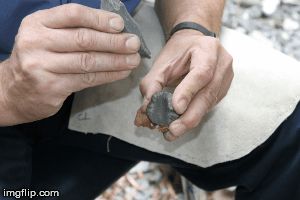Research project
Beyond Prometheus: Pursuing the origins of fire production among early humans
When do fire making tools appear in prehistory, and how might the use of these tools manifest in the archaeological record?
- Duration
- 2013 - 2017
- Contact
- Andrew Sorensen
- Funding
-
 Netherlands Organisation for Scientific Research (NWO) PhDs in the Humanities Grant
Netherlands Organisation for Scientific Research (NWO) PhDs in the Humanities Grant
-
 Stichting Nederlands Museum voor Anthropologie en Praehistorie (SNMAP) subsidy
Stichting Nederlands Museum voor Anthropologie en Praehistorie (SNMAP) subsidy

If the possession of fire loosened the shackles of nature on humankind, the ability to make fire at will broke them. My research sheds light on the origins of artificial fire production by seeking out the tools for the task and exploring the potential archaeological signature of this technology in Middle Palaeolithic contexts.

The ability to control fire is a pivotal trait of human culture and likely influenced both the physical and cultural development of our evolutionary lineage. We know fire fundamentally changed our relationship with the world by making previously uninhabitable climates tolerable, inedible foods palatable and more nutritious, and providing a focal point around which modern social relationships could develop. We know little, however, about when fire became part of the technological repertoire of our early ancestors. This chronological gap prevents a full understanding of how fire affected our physical form and cultural lifeways.
Using Neandertals as a case study, my project employs a multifaceted approach to better understanding the patterns of early fire use and, more specifically, to determine whether Neandertal use of fire was a regular occurrence, or merely an opportunistic phenomenon. To accomplish this task, an assessment will be made of the frequency and reliability of fire residues (i.e. charcoal, ash and heated sediments) and fire proxy data (e.g. heat-affected lithic material and bones) from Middle Palaeolithic (Neandertal) sites, and compare these data to similar evidence from Upper Palaeolithic (modern human) sites to evaluate potential variability in fire use and control between these two groups.
In addition, as a continuation and expansion of the experimental work conducted for my Master research ( Sorensen et al. 2014), microwear analyses of archaeological artefacts and flint assemblages will be conducted to determine if direct physical evidence of artificial fire-making by Neandertals using stone-on-stone methods (i.e. flint and pyrite percussion) is present ( Sorensen and Rots 2014).
By shedding more light on Neandertal fire use practices and how they preserve in the archaeological record, I hope to contribute to the larger debate over when in prehistory regular fire use and artificial fire production were incorporated into the technological repertoire of the genus Homo, thus leading to a better understanding of the interaction between fire and the development of human culture.
I and my research benefit greatly from daily cooperation and interaction with other members of the Fire and Human Origins project, as well as from having access to the Leiden Laboratory for Artefact Studies and to other members of the Material Culture Studies research group at Leiden.
